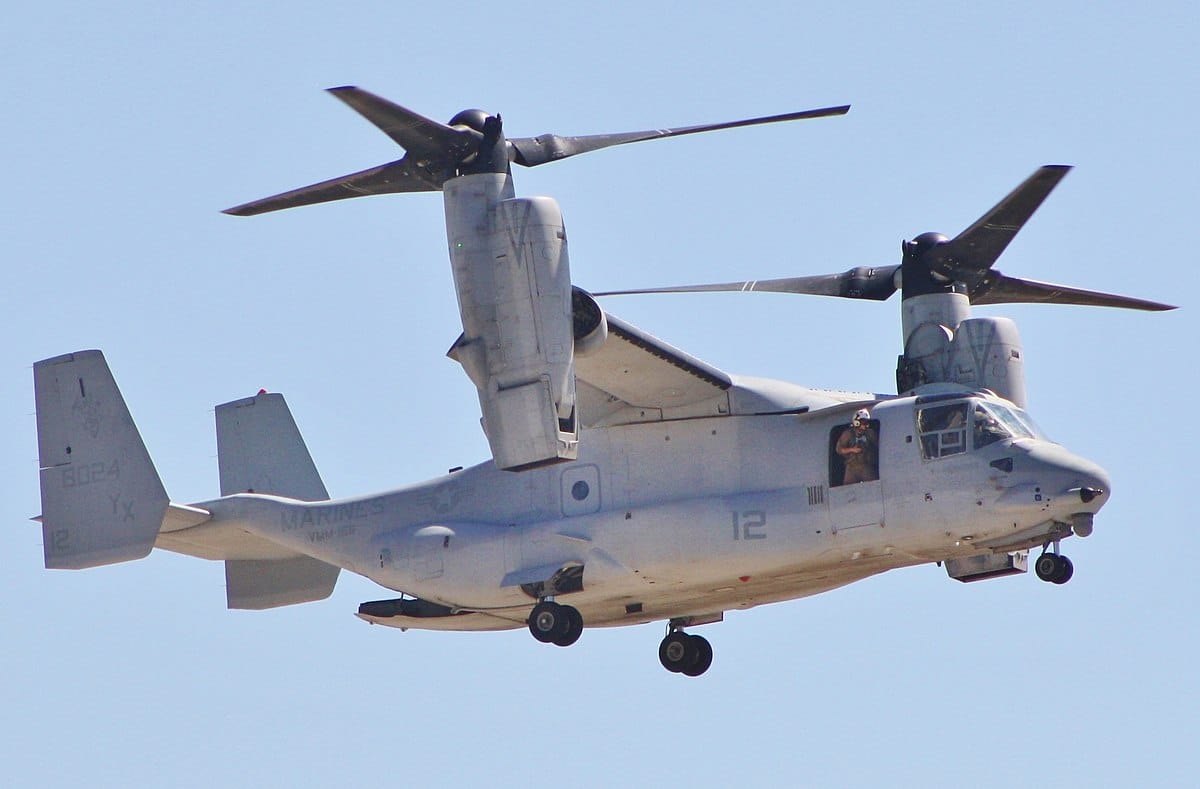Aerospace
The US Air Force no longer grounds its MV22 Osprey
The MV 22 osprey fleet was grounded when one of its aircraft crashed two weeks ago in the desert of southern California

The V22 Osprey aircraft is being reactive by the US air force. The MV 22 osprey fleet was grounded when one of its aircraft crashed two weeks ago in the desert of southern California, sparking concerns about the crew’s and the plane’s safety.
What caused the crash, exactly?
Technically challenging, this aircraft has a crucial component for changing vertical rotors to horizontal ones. The skill of the pilots is also essential to flying this aircraft. Clutch trouble is the main factor in this accident. This issue has been known since 2010, but instead of being corrected, pilots have received training on safe flying practices and emergency management.
10 things which are really special for the US president in AIR FORCE ONE(Opens in a new browser tab)
Although this aircraft presents flying obstacles, the US Marine and Air Force benefit more from its employment. Both a helicopter and an airplane can be operated by this one. Almost 400 aircraft have been produced since 1988. Around 27,442 kg is the maximum takeoff weight for it. More than 9,000 kg of cargo space is accessible, and the aircraft can cruise at a speed of 509 km/h.
After two clutch failures in the previous six weeks, Air Force Special Operations Command grounded its fleet of 52 CV-22 Ospreys on Tuesday. There were two other events after that in 2017.
What steps will the US Air Force take to address the Osprey aircraft issue next?
This issue arises when the clutch that joins the rotor gearbox and engine of the propeller slides. In order to prevent the aircraft from crashing, the Osprey transfers the power load to the other engine nearly immediately.
The osprey lurches as a result of the engine’s power load transferring over a millisecond time span and a considerable amount of torque. Additionally, fixing the gearbox would cost them nearly 2.5 million dollars, so that is not an inexpensive fix. In order to avoid an accident, an aircraft lands in this situation out of safety concerns.
How does a Black Box Work ? its importance in an Aircraft.(Opens in a new browser tab)
How did US marines handle this plane after 533,000 hours of flight?
The Marine Corps is knowledgeable about these aircraft. They have a fleet of 296 Ospreys and have flown 533,000 hours with them. Most marine pilots are currently receiving training to handle such alerts, and they also teach other pilots who are currently flying how to manage them.
In addition, there should be an alert to handle such a scenario carefully. Those instruments will frequently alert the aircrew that such a problem is about to occur so the pilots can quickly and safely land them. More than two-thirds of these problems have occurred seconds after takeoff when power is quickly applied.
Russia prohibits its pilots from working for foreign airlines.(Opens in a new browser tab)
How many Osprey V-22 plane crashes have there been so far?
51 people have died as a result of 13 hull-loss accidents involving the V-22 Osprey. Between 1991 and 2000, there were four crashes during testing that killed 30 people. The V-22 has seen eight crashes, 16 fatalities, and other smaller issues since it began operations in 2007. The aircraft’s history of accidents has caused significant debate over potential safety concerns.

Aerospace
When Ratan Tata was denied entry to the airfield at the Aero India show, he waited

During our visit to Aero India 2019, we had the unexpected opportunity to see Ratan Tata at the event, which was a thrilling moment for us. However, there was a surprising hiccup when the security staff didn’t allow him to enter due to a lack of a security pass.
Despite this, he remained calm and patiently waited for about 20 minutes until a member of the Tata team brought him the required pass, after which he calmly proceeded inside. It was a humbling sight, showcasing his composed demeanor even in such situations.
Ratan Tata ji is not only a renowned industrialist but also a trained pilot, holding a pilot’s license. In 2007, he became the first Indian civilian to fly the F-16 Falcon during the Aero India show in Bangalore—a proud moment for the nation.
His passion for aviation extended beyond flying, as he played a key role in shaping India’s aerospace industry. Under his leadership, Tata ventured into manufacturing and maintaining aerospace components while upholding its legacy of quality. Notably, Tata’s collaboration with Airbus to develop and manufacture the C295 aircraft is a testament to its growing influence in the sector.
-

 Aviation2 months ago
Aviation2 months agoBoeing confirms 797: A New Era for Mid-Size Aircraft
-

 Aviation2 months ago
Aviation2 months agoMicrosoft Flight Simulator Raises $3 Million to Bring Back the An-225 Mriya
-

 Aviation2 months ago
Aviation2 months agoLockheed and Tata Team Up to Build C-130J MRO Facility in India
-

 Tech2 months ago
Tech2 months agoChina Developing Jet to Travel Anywhere in Two Hours
-

 Airlines2 months ago
Airlines2 months agoQantas Engineers Stage Walkout Over Cost of Living Concerns
-

 Airlines2 months ago
Airlines2 months agoQatar Citizens Can Travel to the United States Without a Visa
-

 Aviation2 months ago
Aviation2 months agoBoeing Offers 25% Pay Increase & Promise to Build Next Plane in Seattle
-

 Airlines2 months ago
Airlines2 months agoAirbus Beluga to Deliver Spare Parts for Stranded British Airways A350








